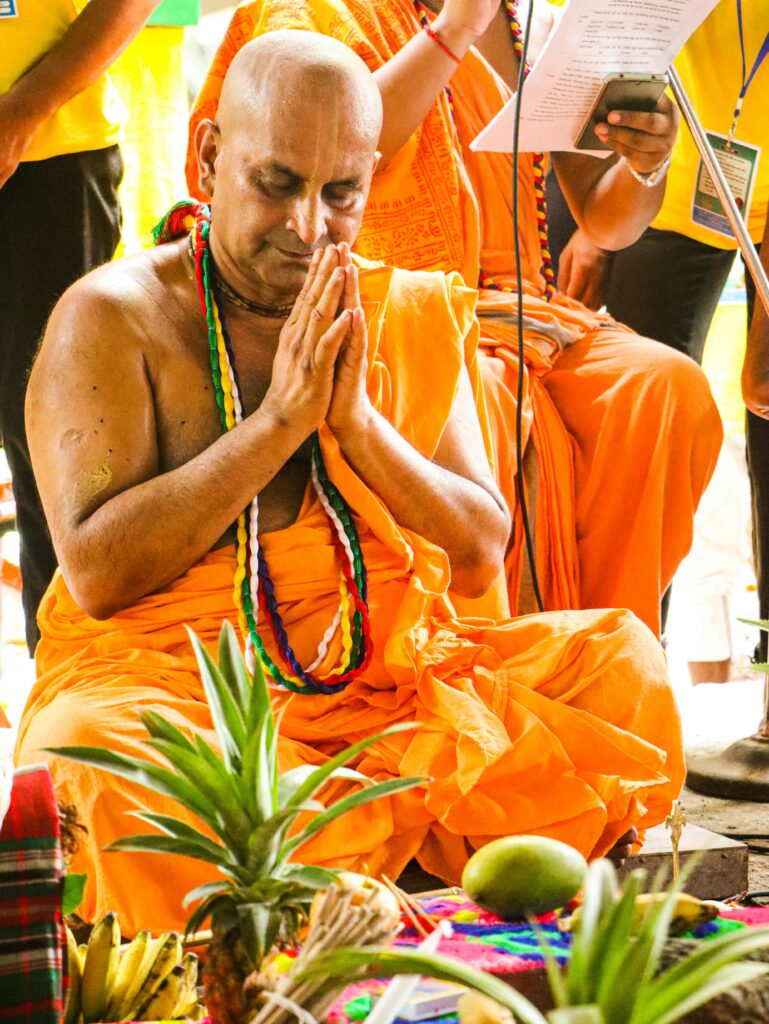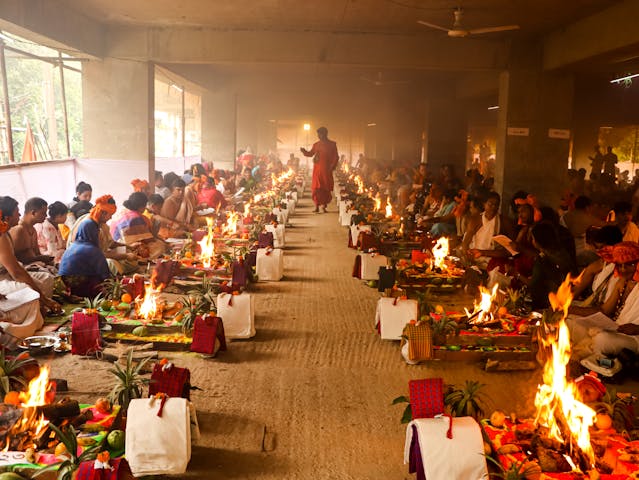The origins of Brahmins, India’s esteemed priestly class, are deeply rooted in the rich tapestry of ancient Indian history and religious traditions. Tracing their historical footprints unveils a complex evolution shaped by centuries of cultural, social, and religious dynamics.
The term “Brahmin” finds its etymological roots in the Sanskrit word “Brahmana,” which denotes one who possesses spiritual knowledge and wisdom. According to ancient texts such as the Vedas, Brahmins were believed to have emerged from the mouth of the cosmic creator, symbolizing their role as custodians of sacred knowledge and spiritual wisdom.
The earliest mentions of Brahmins can be found in the Rigveda, one of the oldest scriptures of Hinduism, dating back to around 1500 BCE. In these ancient texts, Brahmins are depicted as priests and ritual specialists responsible for performing religious ceremonies, reciting hymns, and preserving sacred knowledge through oral tradition.
Over time, the role of Brahmins expanded beyond religious duties to encompass various domains of social and intellectual life. They became revered as scholars, educators, and advisors to kings and rulers, wielding significant influence in shaping societal norms and cultural practices.
The evolution of Brahminism was intricately linked to the broader sociopolitical landscape of ancient India. During the Vedic period, Brahmins occupied the highest echelons of society, enjoying privileges and patronage from ruling elites. Their authority and status were further solidified by the codification of social hierarchy in texts such as the Manusmriti, which delineated the four varnas or social classes, with Brahmins placed at the top.
However, the historical trajectory of Brahmins was not without challenges and transformations. With the advent of Buddhism and Jainism in the 6th century BCE, Brahminical authority faced ideological competition and critiques of ritualism and caste hierarchy. Nevertheless, Brahmins managed to adapt and coexist with emerging religious traditions, maintaining their influence as custodians of orthodoxy and tradition.
The medieval period witnessed further shifts in Brahminical authority with the rise of regional kingdoms and the patronage of new ruling dynasties. Brahmins played pivotal roles as advisors, administrators, and intellectuals in these kingdoms, contributing to the proliferation of literature, art, and philosophy across India.
The colonial era marked another significant chapter in the evolution of Brahmins, as British colonization brought new challenges and opportunities. While colonial policies undermined traditional structures of authority, they also provided avenues for Brahmins to excel in modern education, administration, and professions, leading to their dominance in fields such as law, academia, and bureaucracy.
In contemporary India, Brahmins continue to navigate a changing social landscape characterized by globalization, democratization, and social mobility. While their traditional roles as priests and scholars persist, Brahmins have also embraced new opportunities in diverse fields such as business, technology, and politics, reflecting their adaptability and resilience in the face of modernity.
Cultural Significance: Unveiling the Integral Role of Brahmins in Indian Society
In the kaleidoscope of Indian society, Brahmins occupy a central and revered position, their influence extending across realms of culture, religion, education, and social organization. To grasp the cultural significance of Brahmins is to delve into the intricate fabric of Indian civilization, where their presence is woven deeply into the tapestry of tradition and heritage.
At the heart of Brahminical culture lies a profound reverence for knowledge, spirituality, and moral righteousness. Brahmins are traditionally regarded as custodians of sacred wisdom, entrusted with the preservation and transmission of ancient scriptures, rituals, and philosophical teachings. Their role as priests and scholars imbues them with spiritual authority, shaping the religious practices and moral values of Indian society.
Brahmins play a pivotal role in religious ceremonies and rituals, serving as intermediaries between devotees and the divine. Through their expertise in Vedic chants, rituals, and scriptural interpretation, Brahmin priests facilitate the worship of deities, the performance of sacraments, and the observance of auspicious rites marking life’s significant milestones—from birth to death and everything in between.
Beyond their religious duties, Brahmins are esteemed for their contributions to intellectual and cultural life. From ancient times, Brahmin scholars have been pioneers in literature, philosophy, mathematics, astronomy, and other fields of knowledge, producing foundational texts that continue to inspire and enrich Indian thought. Their legacy endures in classical Sanskrit literature, philosophical treatises, and scientific advancements that have shaped India’s intellectual heritage.
Brahmins also wielded considerable influence as advisors, counselors, and educators to royalty and rulers, guiding the governance and administration of kingdoms across India. Their erudition and ethical integrity earned them the respect and patronage of rulers, who relied on Brahmin wisdom to uphold justice, morality, and social order in their realms.
Moreover, Brahmins have played a crucial role in upholding and perpetuating social norms, customs, and traditions that define Indian identity. Through their adherence to Vedic principles, caste regulations, and moral codes, Brahmins have served as custodians of cultural continuity, ensuring the transmission of heritage from generation to generation.
In contemporary India, while the influence of Brahmins has evolved amidst social, economic, and political transformations, their cultural significance remains palpable. Brahmins continue to be revered as symbols of wisdom, learning, and moral rectitude, their presence felt in diverse spheres of society—from academia and religion to politics and the arts.

Contemporary Challenges: Addressing Modern Realities Within the Brahmin Community
In navigating the complexities of contemporary Indian society, the Brahmin community, like any other social group, faces a spectrum of challenges that reflect the evolving dynamics of modernity, globalization, and social change. These challenges, ranging from socio-economic disparities to identity politics, require nuanced understanding and proactive engagement to ensure the well-being and resilience of the Brahmin community in the 21st century.
One of the foremost challenges confronting the Brahmin community in contemporary India is the issue of socio-economic disparity. While Brahmins historically occupied privileged positions in society, with access to education, land ownership, and professional opportunities, the changing socio-economic landscape has brought about disparities within the community itself. Economic liberalization, urbanization, and globalization have led to shifts in occupational patterns and employment opportunities, resulting in socio-economic stratification among Brahmins, with some segments facing marginalization and economic vulnerability.
Identity politics and caste-based reservations pose another significant challenge to the Brahmin community’s cohesion and well-being. In the wake of affirmative action policies aimed at addressing historical injustices and promoting social equity, Brahmins, perceived as beneficiaries of historical privilege, have often been targeted or marginalized in public discourse and policy implementation. This has led to feelings of resentment, insecurity, and identity crisis within the community, exacerbating inter-caste tensions and social divisions.
Furthermore, the erosion of traditional values and cultural practices in the face of rapid modernization and globalization poses a challenge to the preservation of Brahmin identity and heritage. With younger generations increasingly influenced by global trends, consumerism, and secular ideologies, there is a risk of dilution or loss of traditional knowledge, rituals, and cultural customs that have defined Brahmin identity for centuries. This cultural disconnect may lead to a sense of alienation and loss of cultural pride among Brahmins, further exacerbating intra-community tensions and identity crises.
Moreover, the emergence of social media and digital platforms has facilitated the dissemination of misinformation, stereotypes, and hate speech targeting the Brahmin community. Stereotypes portraying Brahmins as elitist, privileged, or regressive often perpetuate negative perceptions and prejudice, fueling social stigma and discrimination. Addressing these negative narratives and promoting a more nuanced understanding of Brahmin identity and contributions is crucial for fostering social harmony and inclusivity.
Despite these challenges, the Brahmin community has shown resilience and adaptability in responding to modern realities. Initiatives aimed at socio-economic empowerment, educational upliftment, and community development are emerging to address disparities and promote upward mobility within the community. Moreover, efforts to reclaim and revitalize cultural heritage, promote inter-caste dialogue, and foster solidarity among Brahmins are gaining momentum, signaling a collective commitment to overcoming internal divisions and external pressures.
Diversity and Dynamics: Exploring Regional Variations and Subgroups Among Brahmins
The Brahmin community, often perceived as a monolithic group, actually exhibits a rich tapestry of diversity and regional variations across India. Spanning different geographical regions, linguistic backgrounds, and cultural traditions, Brahmins comprise numerous subgroups, each with its own unique customs, rituals, and social dynamics. Exploring this diversity provides valuable insights into the complexity and richness of Brahmin identity in contemporary India.
1. North India:
In North India, Brahmins are predominantly classified into two major groups: Saraswat Brahmins and Kanyakubja Brahmins. Saraswat Brahmins, found primarily in states like Uttar Pradesh, Rajasthan, and Punjab, trace their lineage to the ancient Saraswati River region and are known for their expertise in Vedic rituals and Sanskrit scholarship. Kanyakubja Brahmins, on the other hand, are concentrated in the Gangetic plains of Uttar Pradesh and Bihar, and are renowned for their association with the Kanyakubja lineage and contributions to literature, philosophy, and astrology.
2. South India:
Southern India is home to a diverse array of Brahmin subgroups, each with its own distinct cultural traditions and practices. In Tamil Nadu, Iyer and Iyengar Brahmins are prominent, with Iyers predominantly following the Shaiva tradition and Iyengars adhering to the Vaishnava tradition. In Karnataka, Smartha Brahmins, Madhwa Brahmins, and Shivalli Brahmins are prevalent, each with their own unique religious affiliations and customs. Andhra Pradesh and Telangana are home to Niyogi Brahmins, known for their contributions to administration, education, and arts.
3. East India:
In East India, Brahmins are found in states like West Bengal, Odisha, and Bihar, where they play significant roles in religious rituals, cultural events, and intellectual pursuits. In West Bengal, Brahmins are often classified into groups such as Rarhi Brahmins, Varendra Brahmins, and Kulin Brahmins, each with distinct regional affiliations and social status. In Odisha, Brahmins belonging to different gotras (clans) and sects perform priestly duties in temples, conduct religious ceremonies, and uphold cultural traditions.
4. West India:
The Brahmin community in West India is characterized by a diverse range of subgroups, including Chitpavan Brahmins in Maharashtra, Deshastha Brahmins in Karnataka, and Gujarati Brahmins in Gujarat. Chitpavan Brahmins, for instance, are renowned for their contributions to literature, politics, and social reform movements, while Deshastha Brahmins have historically served as priests, scholars, and administrators in the Deccan region. Gujarati Brahmins, meanwhile, are known for their entrepreneurial spirit, educational achievements, and cultural contributions.
5. Central India:
Central India is home to various Brahmin communities, including Saryupareen Brahmins in Uttar Pradesh, Pancha-Gauda Brahmins in Madhya Pradesh, and Chhattisgarh Brahmins in Chhattisgarh. These subgroups have distinct cultural practices, linguistic preferences, and regional affiliations, reflecting the diverse heritage and historical legacies of the region.
Overall, exploring the diversity and dynamics of Brahmin subgroups across India reveals the intricate interplay of regional, cultural, and social factors that shape Brahmin identity and community life. While these subgroups share common threads of Brahminical heritage and traditions, each retains its own distinct character, contributing to the vibrant mosaic of Indian society. Understanding and appreciating this diversity enriches our appreciation of Brahmin culture and its multifaceted contributions to Indian civilization.
Preservation and Progress: Initiatives to Safeguard Brahmin Traditions and Adapt to Changing Times
In the face of modernization, globalization, and socio-economic transformations, initiatives aimed at preserving Brahmin traditions while fostering progress and adaptation have become increasingly vital. These efforts seek to safeguard the cultural heritage, knowledge systems, and social cohesion of the Brahmin community, ensuring its resilience and relevance in a rapidly changing world.
1. Cultural Preservation:
Efforts to preserve Brahmin traditions encompass a range of activities aimed at safeguarding rituals, customs, and cultural practices passed down through generations. Cultural organizations, educational institutions, and community forums play key roles in organizing festivals, conducting religious ceremonies, and promoting awareness of Brahmin heritage. Initiatives such as documentation of oral traditions, archival preservation of manuscripts, and restoration of heritage sites contribute to the preservation of Brahmin culture for future generations.
2. Educational Upliftment:
Promoting educational opportunities and academic excellence among Brahmin youth is essential for fostering progress and empowerment within the community. Scholarships, mentorship programs, and vocational training initiatives help support students from Brahmin families in pursuing higher education and professional careers. Educational institutions established by Brahmin trusts and foundations provide specialized training in traditional knowledge systems, Sanskrit studies, and Vedic scriptures, ensuring the continuity of Brahmin scholarship and intellectual legacy.
3. Socio-Economic Empowerment:
Addressing socio-economic disparities within the Brahmin community requires targeted interventions to promote economic mobility, entrepreneurship, and social welfare. Microfinance initiatives, skill development programs, and livelihood support schemes empower Brahmin artisans, small-scale entrepreneurs, and marginalized community members to access resources and opportunities for sustainable livelihoods. Social welfare organizations provide assistance with healthcare, housing, and financial aid to vulnerable segments of the Brahmin community, fostering social inclusion and economic resilience.
4. Adaptation to Modernity:
Adapting Brahmin traditions to contemporary realities involves embracing innovation, technology, and evolving social norms while preserving core values and principles. Digital platforms, social media, and online forums facilitate networking, knowledge sharing, and community engagement among Brahmins worldwide, fostering virtual communities and dialogue across geographical boundaries. Initiatives promoting gender equality, environmental sustainability, and social justice within the Brahmin community reflect a commitment to progressive values and inclusive development in line with changing societal norms.
5. Inter-Community Dialogue:
Promoting dialogue and collaboration with diverse social groups fosters mutual understanding, intercultural exchange, and social harmony within society. Interfaith initiatives, cultural exchange programs, and community outreach events provide platforms for Brahmins to engage with individuals from different backgrounds, fostering empathy, respect, and cooperation. Collaborative projects addressing common challenges such as poverty alleviation, environmental conservation, and disaster relief demonstrate the potential for collective action and solidarity across communities.
Initiatives aimed at preserving Brahmin traditions while fostering progress and adaptation are essential for sustaining the cultural heritage, social cohesion, and resilience of the Brahmin community in a rapidly changing world. By embracing innovation, education, and social empowerment while upholding core values and traditions, Brahmins can navigate the complexities of modernity while preserving the richness and diversity of their cultural heritage for generations to come.



